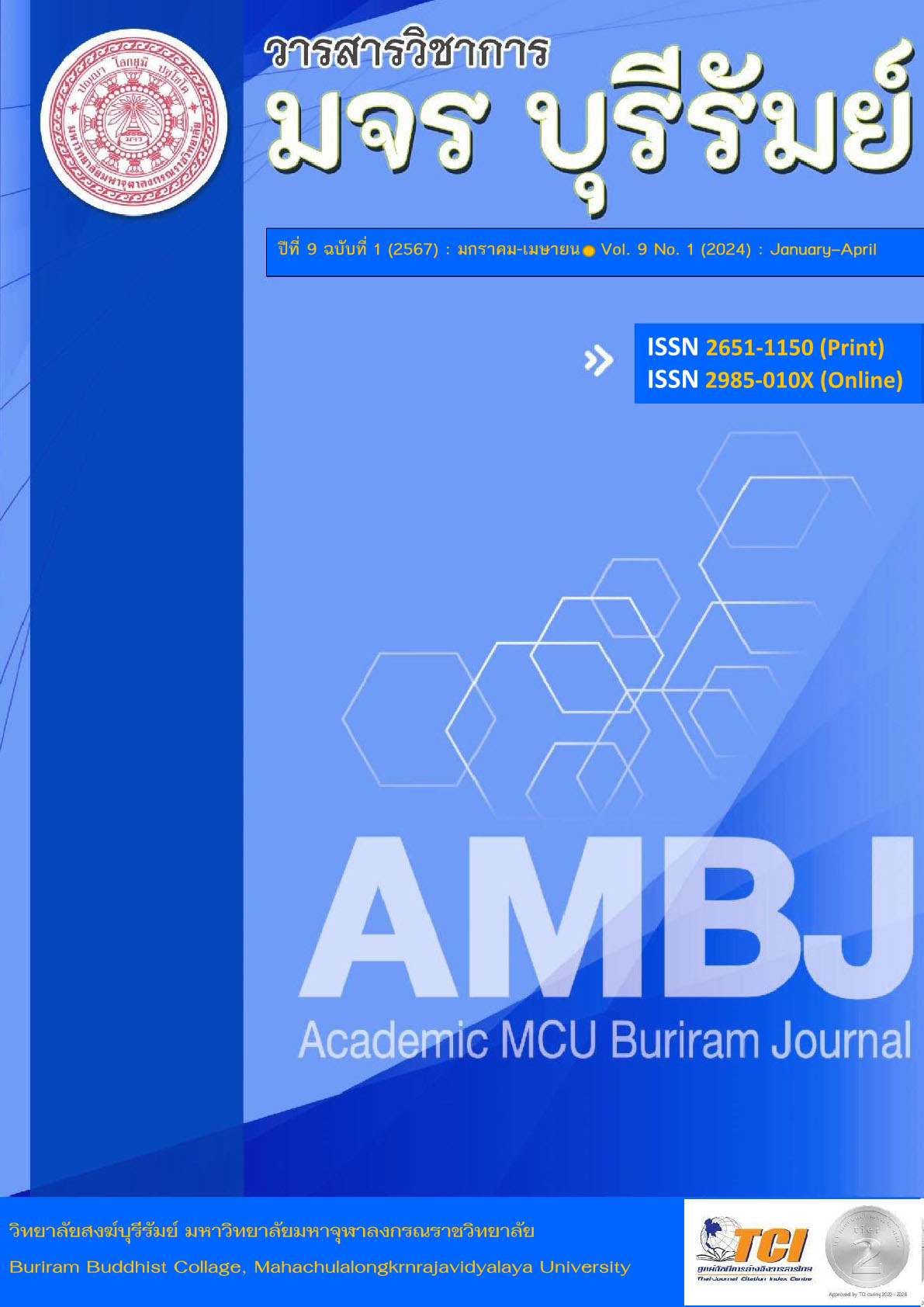Ngao : An Exclamation to Enhance the Role of the Digital Age
Keywords:
Ngao, Teenager, Chat LanguageAbstract
The purposes of this research were: 1) to study the origin of the word " Ngaw " and in what contexts it is used, 2) to study how to create slang today; The method of conducting the study was to study the use of slang by collecting information from online media Twitter and Facebook, from sentences used in 2017, and then collecting sentences in which the word "Ngaw" appeared that it is used in what manner; Including a study of how to create slang by the researcher, synthesizing research, and articles that study slang, and then summarizing and discussing the results.
The research result found that:
1. The origin of the word " Ngaw " found that context in which the word "Ngaw" is used is 1) in messages used to joke among men and women, 2) showing a slight feeling of disappointment, 3. shows the need for sarcasm; The word "Ngaw" is a short exclamation used among Thai teenagers. (2017), commonly used to convey meaning in expressing liking for something, or to express feelings to emphasize a situation, or an event being discussed; with the meaning of understanding language, with just Context-he events being discussed at that time. and that group of speakers; and the results of the study of methods for creating slang from synthesis.
2. It was found that there are methods of creating structural slang from word combinations and the process of creating slang from other special characteristics.
References
กัญญนัช ชะนะจิตร. (2560). ศึกษาการสร้างคำและความหมายของสแลงในเฟซบุ๊ก. วิทยานิพนธ์ศึกษาศษสตรมหาบัณฑิต สาขาวิชาภาษาศาสตร์เพื่อการสื่อสาร. บัณฑิตวิทยาลัย: มหาวิทยาลัยธรรมศาสตร์.
กาญจนา นาคสกุล. (2552). วิบัติของภาษา ต้องรีบหาทางแก้. เข้าถึงได้จาก http://www.sahavicha.com/?name=knowledge&file=readknowledge&id=1386 (สืบค้นเมื่อ 14 มีนาคม 2560).
จินดา เฮงสมบูรณ์. (2542). ภาษาศาสตร์เบื้องต้น. กรุงเทพมหานคร: สุวีริยาสาส์น.
จินตนา พุทธแมตะ. (2547). คำสแลง. วารสารมนุษยศาสตร์ปริทรรศน์, 1(26), 75-87
จุฬาลงกรณ์มหาวิทยาลัย คณะอักษรศาสตร์ ศูนย์การแปลและล่ามเฉลิมพระเกียรติ, ผู้แปล. (2555). พจนานุกรมออกซฟอร์ด-ริเวอร์ บุ๊คส์ อังกฤษ-ไทย. กรุงเทพมหานคร: ริเวอร์ บุ๊คส์.
จุลจอมเกล้าเจ้าอยู่หัว, พระบาทสมเด็จพระ. (2542). พระราชพิธีสิบสองเดือน พระราชนิพนธ์พระบาทสมเด็จพระจุลจอมเกล้าเจ้าอยู่หัว. พิมพ์ครั้งที่ 18. กรุงเทพมหานคร: อมรการพิมพ์.
ดำรงราชานุภาพ, สมเด็จพระเจ้าบรมวงศ์เธอ กรมพระยา. (2542). แบบเรียนเร็ว เล่ม1, 2, 3. กรุงเทพมหานคร: โรงพิมพ์การศาสนา กรมการศาสนา.
ประยูร ทรงศิลป์. (2554). หลักและการใช้ภาษาไทย. พิมพ์ครั้งที่ 2. กรุงเทพมหานคร: มหาวิทยาลัยราชภัฏธนบุรี.
มนัญญา สุดสวาท. (2550). การศึกษาคำสแลงในนิตยสาร Oops. วิทยานิพนธ์ศิลปศาสตรมหาบัณฑิต สาขาวิชาภาษาไทย. บัณฑิตวิทยาลัย: มหาวิทยาลัยเกษตรศาสตร์.
รัชนี ศิริไสยาสน์. (2551). การศึกษาการสร้างคำและความหมายของคำสแลงในพจนานุกรมฉบับมติชน. วิทยานิพนธ์การศึกษามหาบัณฑิต สาขาวิชาภาษาศาสตร์การศึกษา. บัณฑิตวิทยาลัย: มหาวิทยาลัยศรีนครินทรวิโรฒ.
ราชบัณฑิตยสถาน. (2546). พจนานกรมฉบับราชบัณฑิตยสถาน พ.ศ. 2542. กรุงเทพมหานคร: นานมีบุ๊คส์.
รุ่งทิวา ฉัททันต์รัศมี. (2554). การศึกษาคำอุทานในภาษาไทยที่ปรากฏในนิตยสารบันเทิง. วิทยานิพนธ์ศิลปศาสตรมหาบัณฑิต สาขาวิชาภาษาไทย. บัณฑิตวิทยาลัย: มหาวิทยาลัยเกษตรศาสตร์.
วิไลวรรณ ขนิษฐานันท์. (2533). ภาษาและภาษาศาสตร์. กรุงเทพมหานคร: โรงพิมพ์มหาวิทยาลัยธรรมศาสตร์.
ศิรินทิพย์ เด่นดวง. (2561). วัฒนธรรมไทยยุค 4.0 : การใช้ภาษาของคนไทยในสื่อสังคมออนไลน์. การประชุมวิชาการระดับชาติ ครั้งที่ 11. มหาวิทยาลัยราชภัฏนครปฐม.
สมภพ ใหญ่โสมานัง. (2545). การศึกษาการแปลคำอุทานในหนังสือการ์ตูนของวอลท์ ดิสนีย์ เป็นภาษาไทย. กรุงเทพมหานคร: มหาวิทยาลัยมหิดล.
สุพิศตรา อภิชาโต, ไพบูลย์ ดวงจันทร์ และสมิทธ์ชาต์ พุมมา. (2564). ศึกษาการสร้างคำสแลงในหนังสือบันทึกของตุ๊ด. รายงานสืบเนื่องการประชุมหาดใหญ่วิชาการระดับชาติและนานาชาติ ครั้งที่ 12. มหาวิทยาลัยหาดใหญ่.
Downloads
Published
How to Cite
Issue
Section
License
Copyright (c) 2024 Academic MCU Buriram Journal

This work is licensed under a Creative Commons Attribution-NonCommercial-NoDerivatives 4.0 International License.
ทัศนะและความคิดเห็นที่ปรากฏในบทความวารสารฉบับนี้ถือเป็นความรับผิดชอบของผู้เขียนบทความนั้น ไม่ถือเป็นทัศนะและความรับผิดชอบของบรรณาธิการ





